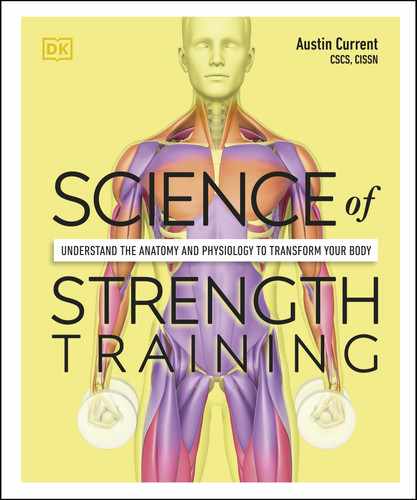Discover the hard science needed to perfect each exercise and build your strongest body - at home or in the gym.
Whether you are looking to tone and sculpt your body, lose weight, give yourself an edge in another sport, support bone strength, or simply improve posture, strength training can help you achieve your goals.
With unique CGI artworks, this book gets under the skin of more than 100 exercises, to identify every muscle worked and show how they engage at every stage, so you can feel you're getting it right - safely and with maximum benefit.
Follow flexible workout programs targeting a range of abilities and aims.
Understand the physiology behind how to build and maintain muscle mass, raise metabolism, and reduce body fat. Apply in-depth dietary advice to maintain a healthy, balanced diet that supports muscle building, including for vegans.
Explore the science behind each lift, press, push, and pull to become your own personal trainer.
How The Book Works
The first section - human physiology - introduces you to the wonder that is skeletal muscle and the mechanisms that underpin strength training's demands on the body. It will help you understand how muscles work and grow, and how the resistance work stimulates muscles to develop strength and size, alongside its positive impacts on bones and connective tissue. It also explains how the body powers muscular work and shows you how to calculate your own daily macronutrient requirements. Lastly, you're given an overview of the benefits to the brain, and the crucial role it plays in attitude and mental health.
The second section - strength exercises - is devoted to a comprehensive collection of strength training exercises to perform, along with many variations offered to compliment your available training equipment, personal preferences, and level of challenge - at home or in the gym. Each exercise displays the muscles being used throughout the movement with detailed instruction on how to achieve proper form and technique; common mistakes are covered, too.
The third section - preventing injury - explores common injuries related to resistance training, with explanations on how to avoid them and how to return to training if you do suffer an injury. A consistent and structured routine, including a proper warm-up, prepares the body for work, and the various mobility exercises and stretches given will help you tune in to how your body is responding to the training.
The final section - how to train - outlines everything you need to know about the variables of effective strength training, such as training volume and fatigue management. Whether you want to build muscle, strength, or endurance, you'll find an easy-to-follow program to suit, as well as alternatives for those wanting to workout more often. Then programs form the base of your training and can be adjusted in the months and years to come.
Table of Contents
- COVER
- HALF-TITLE
- CONTENTS
- HOW TO USE THIS eBook
- Introduction
- Strength training for everyone
- HUMAN PHYSIOLOGY
- STRENGTH EXERCISES
- Introduction to the exercises
- Terminology guide
- LEG EXERCISES
- Barbell back squat
- Variations
- Leg press
- Hack squat
- Stationary lunge with dumbbells
- Variations
- Step up with dumbbells
- Leg curl
- Variations
- Hamstring ball curl
- Leg extension
- Variations
- Barbell glute bridge
- Variations
- Calf raise
- Variations
- Traditional deadlift
- Variations
- CHEST EXERCISES
- Barbell bench press
- Variations
- Dumbbell bench press
- Variations
- High–low cable chest fly
- Variations
- Machine chest fly
- Dumbbell chest fly
- BACK EXERCISES
- Wide-grip vertical pulldown
- Variations
- Neutral-grip horizontal row
- Variations
- Dumbbell trap shrug
- SHOULDER EXERCISES
- Barbell overhead shoulder press
- Variations
- Dumbbell lateral raise
- Variations
- Dumbbell front raise
- Variations
- Dumbbell rear deltoid fly
- Variations
- ARM EXERCISES
- Dumbbell biceps curl
- Variations
- Dumbbell triceps extension
- Variations
- Rope triceps pushdown
- Variations
- ABDOMINAL EXERCISES
- Front plank with rotation
- Side plank with rotation
- Transverse abdominal ball crunch
- Variations
- Hanging knee raise
- Variations
- Cable rotational oblique twist
- Variations
- PREVENTING INJURY
- HOW TO TRAIN
- GLOSSARY
- BIBLIOGRAPHY
- ABOUT THE AUTHOR
- ACKNOWLEDGMENTS
- COPYRIGHT
